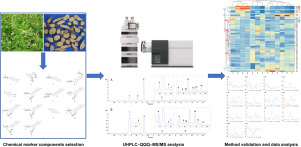当前位置:
X-MOL 学术
›
Phytomedicine
›
论文详情
Our official English website, www.x-mol.net, welcomes your feedback! (Note: you will need to create a separate account there.)
Discovery of chemical markers for identifying species, growth mode and production area of Astragali Radix by using ultra-high-performance liquid chromatography coupled to triple quadrupole mass spectrometry.
Phytomedicine ( IF 7.9 ) Pub Date : 2019-12-23 , DOI: 10.1016/j.phymed.2019.153155 Can-Jian Wang 1 , Fan He 1 , Yu-Feng Huang 2 , Hong-Liang Ma 3 , Ying-Ping Wang 4 , Chun-Song Cheng 1 , Jin-Le Cheng 3 , Chi-Chou Lao 1 , Di-An Chen 1 , Zhi-Feng Zhang 1 , Zhen Sang 5 , Pei Luo 6 , Sheng-Yuan Xiao 4 , Ying Xie 6 , Hua Zhou 6
Phytomedicine ( IF 7.9 ) Pub Date : 2019-12-23 , DOI: 10.1016/j.phymed.2019.153155 Can-Jian Wang 1 , Fan He 1 , Yu-Feng Huang 2 , Hong-Liang Ma 3 , Ying-Ping Wang 4 , Chun-Song Cheng 1 , Jin-Le Cheng 3 , Chi-Chou Lao 1 , Di-An Chen 1 , Zhi-Feng Zhang 1 , Zhen Sang 5 , Pei Luo 6 , Sheng-Yuan Xiao 4 , Ying Xie 6 , Hua Zhou 6
Affiliation

|
BACKGROUND
Astragali Radix (AR) is a well-known Chinese herbal medicine. The quality of AR can be affected by many factors such as species, growth mode and production area, but there are still no chemical markers to distinguish it.
PURPOSE
To explore chemical markers for improving the quality assessment of AR and discover chemical markers for identifying species, growth mode and production area of AR.
METHODS
A highly sensitive, efficient and accurate method based on ultra-high performance liquid chromatography coupled to triple quadrupole mass spectrometry (UHPLC-QQQ-MS/MS) for simultaneous quantitative determination of 14 major chemical components (five flavonoids and nine triterpene saponins) in 94 batches of AR from China, Republic of Korea and Germany was developed for the first time. To explore chemical markers and assess changes in the contents of 14 compounds in the 94 batches of AR samples from different regions, hierarchical clustering analysis (HCA) and principal component analysis (PCA) were performed.
RESULTS
Astragaloside III was not only an important chemical marker for distinguishing two species of AR, i.e.: Astragalus mongholicus and A. membranaceus, but also a potential chemical marker for the classification of cultivated and semi-wild AR. In addition, in the batches of cultivated AR, the content of isoastragaloside II and cyclocephaloside II were greater in batches from the region of Shaanxi Province than that of other Provinces in China, but the content of calycosin-7-O-β-D-glucoside and astragaloside IV, which are the quality control markers of AR required by the Chinese Pharmacopoeia, were higher than that of other Provinces in China. In addition, the content of calycosin-7-O-β-D-glucoside, ononin, calycosin and astragaloside I could be used to identify samples of AR collected from China, Republic of Korea and Germany.
CONCLUSION
This UHPLC-QQQ-MS/MS method could be applied to the quantitative evaluation of AR and could be an important and meaningful reference to develop chemical markers for quality control of AR.
更新日期:2019-12-23



























 京公网安备 11010802027423号
京公网安备 11010802027423号